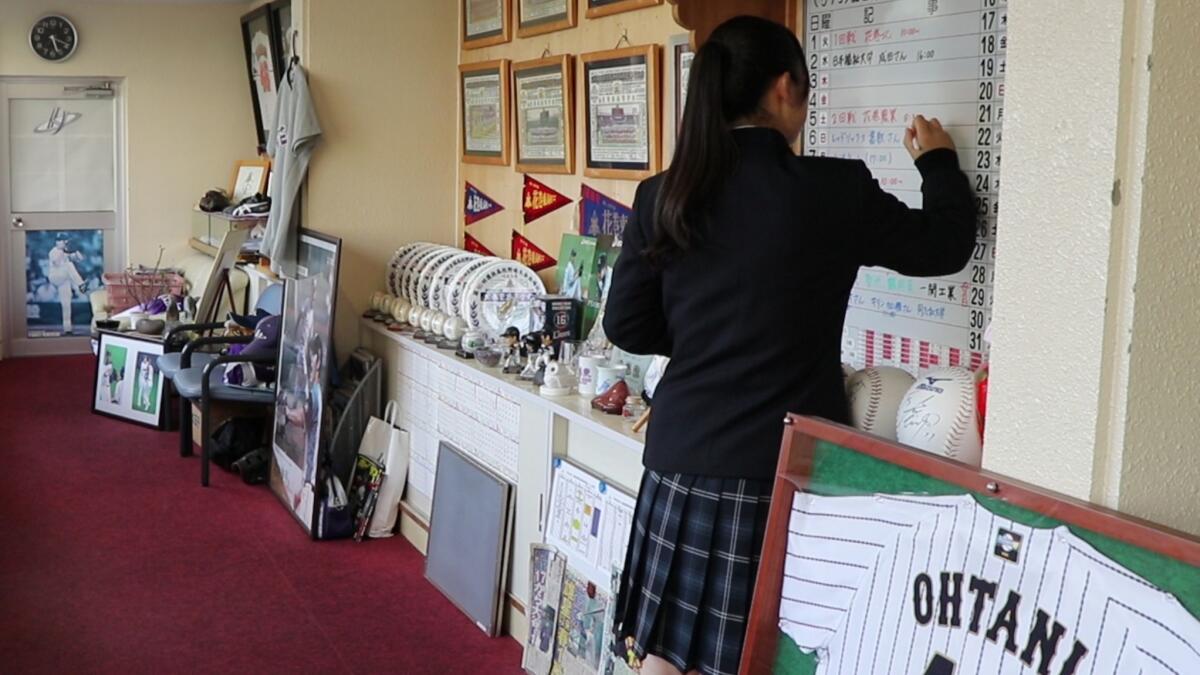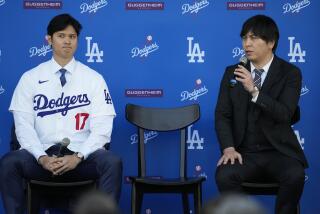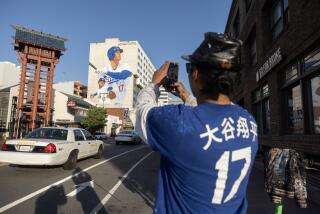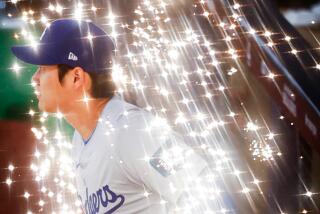Must Reads: Through Shohei Ohtani’s sensational but injury-plagued rookie year, his Japanese hometown watched with pride

Shohei Ohtani’s hometown has watched his rookie season with the Angels with admiration and pride.
Well before Shohei Ohtani joined the Angels, a special exhibit went on display at the Traditional Crafts Museum in his hometown of Oshu: a gold-colored mold of Ohtani’s right hand.
The museum, which also exhibits steel kettle ware, mounted the cast last year when he still played for Sapporo’s Nippon-Ham Fighters. A light keeps it pleasantly warm to the touch.
“It would be a rare opportunity to actually shake Ohtani’s hand, so this is great,” said Katsuji Natori, a 61-year-old office worker, after gripping Ohtani’s hand mold. “His hand is large,” Natori added, with a smile.
Throughout Ohtani’s debut season in Major League Baseball, his hometown has obsessively followed his extraordinary early success, the injury that took him off the pitching mound and his gutsy return to the lineup as a hitter.
The Angels will finish the season Sunday about 20 games out of first place in the American League West, and days later Ohtani, 24, is scheduled to undergo surgery to repair his right elbow. But the admiration and affection people of Oshu have for their favorite native son remain undiminished. There’s also a sense of local pride that the kind of youth baseball Ohtani played here — with its steadfast emphasis on discipline and sacrifice — helped make him the player he is today.
Ohtani was born and raised in Oshu, a city about 250 miles north of Tokyo, in one of the largest rice-producing districts in the Iwate prefecture. Oshu’s population, now about 118,000, has been on a slow decline as younger people move to larger cities with better job prospects. With fewer children available, youth baseball teams in the area have been disappearing, even as Ohtani has brought fame here. Locals get wide-eyed when they hear the name of their hero.
“He is awesome!” said Kosei Takahashi, 11, one Saturday during baseball practice for his Little League team. He wore a green cap and navy-colored uniform emblazoned with orange letters reading “Mizusawa.” That’s the team Ohtani played for when he was in elementary school.
“He hit a home run in his second game” with the Angels, Kosei said. “I want to be a Major League Baseball player just like him.”
Baseball kids aren’t the only ones who are starry-eyed about Ohtani.
Kosei’s father, Sadafumi Takahashi, 39, is the team’s baseball coach. Takahashi did not instruct Ohtani, but he said those who witnessed the baseball wunderkind up close rated him as “exceptional.”
Ohtani hit so many home runs in Little League, a 60-foot-high netted fence was erected because so many balls went missing, lost in a river near the field.
All over town, there are reminders of Ohtani’s time here, and the pride in his career. Early in the season, Anetai Elementary School, which Ohtani attended, celebrated his move to the major leagues in the U.S. with a large purple and yellow banner. Referring to him with the honorific of “senpai,” or “senior,” it read, “Good luck! Ohtani Senpai, Our Hope.”
Oshu City Hall has a banner too, which says, “Press onward pitching and hitting.” A copy of Ohtani’s hand cast also is on display at City Hall, but unlike the museum version, it’s not warmed up.
“We are so proud of” Ohtani, said Mika Oikawa, a sixth-grader at Anetai.
The townspeople have been cheering for Ohtani even before he turned pro. Natori, the museum visitor, said he’s been an Ohtani fan since he played for Hanamaki Higashi High School, north of Oshu.
Video highlights of his play are featured regularly on TV networks across Japan, and he’s been a boon to the local agricultural cooperative in the Oshu area. The group has used photos of Ohtani in its ads for the last two years, said Yutaka Onodera, an official with the cooperative, JA Iwate Furusato.
The cooperative’s brand of rice “is doing better due to our posters featuring Ohtani,” Onodera said.
Ohtani was hailed as the “Japanese Babe Ruth” for his rare ability to excel in both pitching and hitting. When he had to stop pitching after suffering an injury to his right elbow in June, the worry in Oshu was palpable — as was relief when he returned to the lineup as a hitter in July.
“I’m relieved Ohtani is back in the game,” Takayoshi Sagawa, Oshu’s chief of the community development section, said at the time. He was among many city officials who every month were often seen wearing red Angels T-shirts emblazoned with “Ohtani” on the back. “I just hope he doesn’t push himself too much that he injures himself again,” he said.
Ohtani became known, in part, because of the Koshien games — two tournaments, one in spring and one in August, that are a must-watch affair for many Japanese. The games are televised live and the winners become front-page news. The intensity and popularity of the tournaments are often compared to the Super Bowl.
The August competition, the All-Japan High School Baseball Championship Tournament, has existed for 100 years. Hanamaki Higashi High’s team has qualified for these tournaments 12 times, but the closest it has come to winning was second place.

“Ohtani was very hard-working from the minute he joined Hanamaki Higashi,” said Hiroyuki Sasuga, manager of the team. Sasuga discovered Ohtani when he was a seventh-grader and helped arranged Ohtani’s recruitment to Hanamaki Higashi. “Ohtani is very teachable, honest and straightforward,” he said.
Ten Hanamaki Higashi graduates have moved on to become professional players, and the team’s demanding regimen is often credited. Practice lasts at least five hours a day, rain or shine. In winter, practice has been known to go until 9 p.m. — even in the snow.
Hanamaki Higashi, like most of the very competitive high school teams in Japan, has many rules. Team members must live in the dormitory. They cannot use social media or messaging platforms. Girlfriends are prohibited. Students are allowed to access their cellphones from 9 p.m. to 11 p.m., when they may call their families, watch YouTube videos and surf online. There’s no soda, no junk food and no instant ramen.
“We only have three years to get a shot at Koshien, and we feel these rules make sense,” said the team’s student captain, Sota Sugawara, 17.
Ohtani was pitching when Hanamaki Higashi played in the spring Koshien games in 2012. After the team was eliminated in the first round, Ohtani blamed himself, writing this note on the back of a large white calendar:
“The chance that we seized in the Koshien was all but lost because of me. But that doesn’t matter now. We will become the best team in Japan by getting closer to our goal step by step, by keeping on playing.”
He never did reach that goal. But in the final week of the Angels’ disappointing season, he’s been impressive at bat. On Monday he hit a home run that, according to laser measurements, left his bat at 112.9 mph — his hardest-hit homer of the year. The next night he hit a game-tying single, and another home run the day after that.
Those hits are reflective of a sign in Hanamaki Higashi’s training room: “A champion is a person who may fall but picks himself up.”
Nagano is a special correspondent.
More to Read
Start your day right
Sign up for Essential California for news, features and recommendations from the L.A. Times and beyond in your inbox six days a week.
You may occasionally receive promotional content from the Los Angeles Times.






